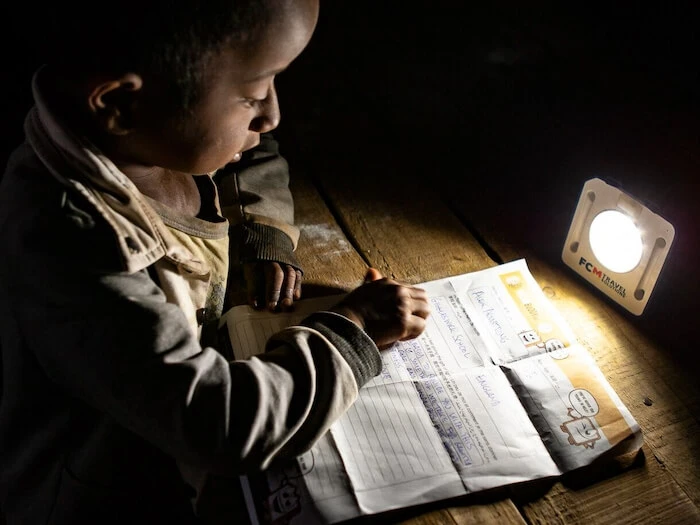& Construction

Integrated BIM tools, including Revit, AutoCAD, and Civil 3D
& Manufacturing

Professional CAD/CAM tools built on Inventor and AutoCAD
One of the most pervasive forms of poverty isn’t food or work scarcity; it’s not having enough access to light, also known as energy poverty. Roughly one in five people (PDF, p. 4) globally have limited or no access to an electricity grid, which means they have to burn kerosene or solid fuels for light when the sun goes down—a practice that leads to 190 million tons of CO2 annually.
“Energy poverty is one of the worst forms of poverty,” says Johnathan Lamb, design and development manager for SolarBuddy, an Australian nonprofit working to bring light where it’s needed most. “Every night, more than 700 million people are plunged into darkness, and they often depend on harmful forms of energy like kerosene. Families can spend up to 40% of their income on lighting and cooking fuels, which only feeds the cycle of poverty. Fighting energy poverty fights the cycle of poverty, and it’s a crucial part of a sustainable and just world.”
Energy poverty has a disproportionate impact on children. Kids in emerging economies are exposed to the same harmful fumes, respiratory problems, and burn injuries as adults (4.3 million people die each year from indoor air pollution), but, additionally, a lack of access to adequate light also reduces studying time, which affects children’s education.
Lamb and his colleagues want to change all that. SolarBuddy’s solution: a simple handheld light that can last as long as a decade, seeing each child through his or her schooling years.
Based in Brisbane, Australia, and with a presence in the United States, UK, India, and the Pacific island nation of Vanuatu, the company started in 2011 when inventor and social impact entrepreneur Simon Doble read in Time magazine that more than a billion people live without safe and reliable lighting. Lamb, an industrial designer by training, joined in 2018.
SolarBuddy has distributed 125,000 lights to kids in Papua New Guinea, Cambodia, Zimbabwe, and the Dominican Republic, and many others have gone to Vanuatu, India, Timor, Thailand, Myanmar, Nepal, Tibet, and numerous African countries. And it’s working. SolarBuddy’s study in Papua New Guinea showed that students studied 78% longer using its solar lights. Students also are retaining more information, getting better grades, and significantly improving their health and well-being.
But Lamb says one of the biggest challenges concerning energy poverty is that it’s a largely unknown problem. “We have to educate and raise awareness about it,” he says. “In our Event and Education programs, everyone from school students to corporate [employees] can assemble the lights and write letters for the kids living in energy poverty who’ll receive them.”
In 2019, SolarBuddy got the attention of the Autodesk Foundation, and a team was assembled to help extend its reach. More than 3,000 Autodesk staff assembled SolarBuddy’s flagship product. Autodesk also provided software to refine product designs, leveraging expertise across professional disciplines. The result has been a gratifying 7 million lighted study hours given to kids.
The vanguard of SolarBuddy’s products is the JuniorBuddy, a hardy workhorse that’s extremely durable, waterproof, easy to assemble, and child-friendly. The JuniorBuddy also has to be adaptable. Many regions classify lithium as a dangerous good, which means the JuniorBuddy must be built to handle a variety of battery technologies without needing different casings to accommodate different markets.
The original model was designed in 2016; a new update is meant to maximize the product’s social impact. “The new design will reduce the time needed for quality control and improve the electronics so they have more longevity and usability,” Lamb says. “We also wanted it to be more versatile so we can use it for more applications, particularly disaster relief. We’ve already seen how beneficial they can be after we helped with the Australian bushfires and Cyclone Harold in Vanuatu.”
Material and cost savings were also a priority. The redesign yielded the innovation of packaging that doubles as a system to filter and transport water. Before production, the team used Autodesk Moldflow Insight to virtually simulate the manufacturing process and thereby optimize the redesign to lower part cost and reduce manufacturing defects.
Collaboration was an important consideration when the team remade JuniorBuddy from the ground up. The workflow and design had to be location-agnostic. In a pandemic-ravaged world, it had to be done completely online and often in real time, sometimes between colleagues who were used to working together in an office or studio.
JuniorBuddy parts such as the circuit boards were redesigned and iterated in Autodesk Fusion 360, where engineers could subject them to rigorous simulation and virtual testing, prototype parts, and then send them to 3D printers to confirm real-world performance.
SolarBuddy partners with schools and companies worldwide to assemble the lights, which are then transported to where they’re needed. Students and benefactors can then keep in touch with the kids they’ve helped through personal letters and updates.
To those in the affluent West, the age-old battle to conquer the darkness of night seems like something forebears Thomas Edison, Nikola Tesla, and George Westinghouse took care of when our great-grandparents were kids. It can be shocking to realize how desperate the need for light remains in so much of the world today—but SolarBuddy rages against the dying of the light.
After growing up knowing he wanted to change the world, Drew Turney realized it was easier to write about other people changing it instead. He writes about technology, cinema, science, books, and more.
D&M
D&M
AECO









